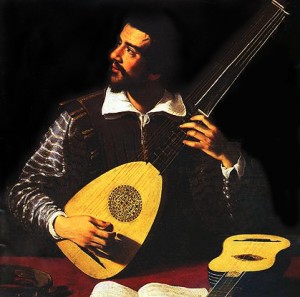Carissimi’s Roman Colleagues
In addition to four vocal works by Carissimi, Magnificat’s November program will include three instrumental compositions by composers active in Rome during Carissimi’s lifetime: keyboard works by Michelangelo Rossi and Girolamo Frescobaldi, and a toccata for theorbo by Johann Hieronymus Kapsberger. All three were among the finest virtuosi active in Rome during the first half of the 17th century and it is certain that their paths crossed with Carissimi after his arrival in 1629.
A remarkably versatile musician, Michelangelo Rossi held prominent positions as a composer, violinist, organist, and most likely also as a singer. Rossi was most famous during his lifetime as a virtuoso violinist (in pay records in Savoy he is often referred to as “Michelangelo il Violino”,) though no examples of his music for that instrument survive. Born into a musical family in Genoa, Rossi moved to Rome by 1624 and entered the service of Cardinal Maurizio of Savoy, where he worked with Sigismondo d’India, whose influence on Rossi’s vocal music is striking. During this period he also encountered Frescobaldi, with whom he may have studied.
Rossi published two books of madrigals and his opera Erminia sul Giordano with a libretto by Giulio Rospigliosi (who later became Pope Clement IX) based on Tasso’s Gerusalemme liberata was performed in the theater of the Palazzo Barberini at Carnival 1633. A second opera, Andromeda was produced in Ferrara in 1638. Our program includes Rossi’s Toccata Settima from his collection Toccate e Correnti d’Intavolatura d’Organo e Cimbalo, published posthumously by Ricarii in Rome in 1657. It’s highly chromatic language and mannerist style is similar to that of Frescobaldi and Froberger.
Widely recognized a the finest lute virtuoso of his time, Johann Hieronymus Kapsberger, was the son of an Austrian Colonel stationed in Venice and spent his entire life in Italy. In 1604, at the age of 24, he published his Libro primo d’intavolatura di Chitarrone, from which the Toccata Arpeggiata on our program is drawn. In 1605 the young “Alemanno nobile” went to Rome, where he entered papal service, and by 1610 he had begun a prolific series of publications in a variety of genres.
In 1624 Kapsberger entered the service of Cardinal Barberini, one of the most important centers of arts and science in Europe in the early Baroque period. He also became close to Galileo Galilei, who also frequented the Barberini household, and he performed concerts with Frescobaldi and Stefano Landi, who also served the Barberinis at the same time. He remained in the service of the Barberini until 1646.
Most familiar to modern audiences, Girolamo Frescobaldi was one of the most highly respected performers and composers of the first half of the seventeenth century. A student of the great Luzzaschi in Ferrara, Frescobaldi was elected to the position of organist at the basilica of St. Peter’s in Rome in 1608, at the age of 25. He remained associated with St. Peter’s for the rest of his life, and, while his official duties as organist did not require composing, it seems likely that many of his sacred works that survive were in fact written for St. Peter’s.
The writer Giustiniani commented in the 1620s that “for Organ and Harpsichord, Frescobaldi of Ferrara carries off all the honors, both in his skill and in the agility of his hands.” His compositions for keyboard influenced not only his contemporaries but composers well into the 18th century, including Buxtehude and Bach. Today, his fame rests almost entirely on his keyboard music, but he also composed a significant body of sacred and secular vocal music including two double-choir settings of the mass ordinary, several books of madrigals and numerous sacred motets. Our program includes a Canzon from Frescobaldi first publication, the Ricercari, et canzone of 1615.


